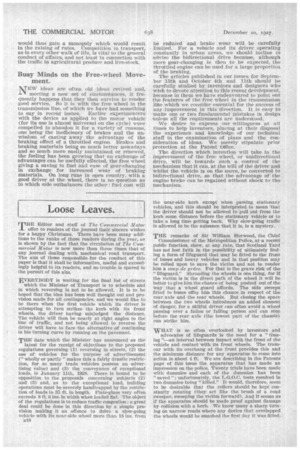Loose Leaves.
Page 36

If you've noticed an error in this article please click here to report it so we can fix it.
THE Editor and staff of The Commercial Motor offer to readers of -the journal their sincere wishes for a happy Christmas. There have been many additions to the ranks of those readers during the year, as is shown by the fact that the circulation of The Commercial Motor is now More than three times that of any journal dealing with mechanical road transport. The aim of those responsible for the conduct of this paper is that it shall be informative, useful and exceedingly helpful to its readers, and no trouble is spared in the pursuit of this aim.
EVERYBODY is waiting for the final list of streets
which the Minister of Transport is to schedule and in which reversing is not to be allowed. It is to be hoped that the idea has been well thought out and provision made for all contingencies, and we would like to be there when the -first vehicle which its driver is attempting to turn strikes the kerb with its front wheels, the driver having misjudged the distance. The vehicle will then be nearly at right angles to the line of traffic, and not being allowed to reverse the driver will have to face the alternative a continuing in his turning curve by running on the pavement.
THEdate which the Minister has announced as the
latest for the receipt of objections to the proposed regulations governing (I) reversing in streets, (2) the use of vehicles for the purpose of advertisement ("wholly or partly" makes this a fairly drastic restriction, for so many trade vehicles possess an advertising value) and (3) the conveyance of exceptional loads, is January 11th, 1928. There is bound to be opposition to tile proposals concerning subjects (2) and (3) and, as to. the exceptional load, building operations must be severely handicapped by the restriction of loads to 35 ft. in length. Plate-glass very often exceeds 8 ft. Gins, in width when loaded flat. The object of the regulations is to reduce traffic congestion : a great deal could be clone in this direction by a simple provision making it an offence to drive a slow-going vehicle with its near-side wheel more than 18 ins, from 518 the near-side kerb except when passing stationary vehicles, and this should be interpreted to mean that the driver should not be allowed to Pull out from the kerb some distance before the stationary vehicle or to take a long time getting back. Why slow-going traffic is allowed to be the nuisance that it is, is a mystery.
THE remarks of Sir William Horwood, the Chief
Commissioner of the Metropolitan Police, at a recent public function, show, at any rate, that Scotland Yard has not lost faith in the possibility of ultimately finding a form of lifeguard that may be fitted to the front of buses and heavy vehicles and in that position may be relied upon to save the victim and not to render him a coup de grace. For that is the grave risk of the "lifeguard." Shrouding the wheels is one thing, for if the victim is in the direct path of the wheel it will be better to give him the chance of being pushed out of the way that a wheel guard affords. The side sweeps fitted to buses offer him this chance in respect of the rear axle and the rear wheels. But closing the space between the two wheels introduces an added element of danger, for a skilful driver can often avoid a wheel passing over a fallen or falling person and can stop before the rear axle (the lowest part of the chassis) can strike him.
WHAT is so often overlooked by inventors and advocates of lifeguards is the need for a "timelag "—an interval between impact with the front of the vehicle and contact with its front wheels. The tramcar with its overhang at the front provides this and the minimum distance for any apparatus to come into action is about 4 ft. We are describing in the Patents page of this issue the apparatus that has -made an impression on the police. Twenty trials have been made with dummies and each of the dummies has been " saved "; unfortunately, the L.G.O.C. tests resulted In two dummies being "killed." It would, therefore, seeni to be desirable that the -rollers should be kept constantly rotating (they act like the brush of a road sweeper, sweeping the victim forward). And it seems as if the apparatus should be made proof against damage by collision with a kerb. We know many a sharp turning on narrow roads where any device that overlapped the wheels would be smashed the first day it was fitted.




































































































